Introduction
The iFlash used with a CF card as shown in my previous article will double the runtime compared to the original Hard Drive, but how does the CF compare to using my latest gen SD-CF Adapter and an SD card?
The Equipment
So for this test I decided to use the newest 7g iPod Classic, as this was donated to me for test. As SD card technology uses a serial transmission method, I expect power consumption to increase with increasing card speeds. So I opted to test a slower SDHC card and a new UHS-I SDXC in my comparison with the CF card.
- 7g iPod Classic
- New 850mAh Battery (thick iPod battery)
- iFlash
- 5th Gen SD-CF Adapter
- 266x 32Gb Compact Flash card
- Class 10 8Gb SDHC card
- UHS-I 64Gb SDXC card
All the cards have exactly the same files added in the same order after the iPod is restored using iTunes.
Power Consumption First
So before we do runtime tests, it would be good to get some baseline power consumption measurements of the various combinations. So after connecting the iPod to my bench power supply, the probes of my current meter and logger are attached and the measurements can begin…
As we have seen the peak current drawn varies by a large amount between the test cards – you pay quite a heavy current draw penalty by using the ultra-fast UHS-I card. However, as can be seen by the average current draw over 60 minutes – and the final average power consumption figure, the difference is minimal between the cards.
This can be explained by the fact that while the faster card draws higher peak currents, it probably spends a lot less time doing so. The access times for the slower cards will much longer than the faster card – so while the slower cards may draw lower peak currents, they will draw it for much longer.
So to see that visually I setup my digital storage scope to measure the active time for the drive i/o circuitry on the iPod – this will show us how long the iPod spends actually reading from the ‘drive’. I will also measure the time required to boot from reset, and how long the iPod takes to fill its read-ahead cache with each card.
The screenshots below shows the drive i/o activity playing a video file. The CF card takes 7.71s to fill the read-ahead cache, while the faster SDXC card 5.23s, so the iPod spends close to 50% longer accessing the drive when using the slower CF card.
So the data implies that the runtimes maybe the same between CF and SD, but one thing the data above does not take in to account – Internal Resistance. Internal Resistance (IR) for the layman is the batteries ability to deliver power.
Quick example, if we have a perfect 10v battery which has 0ohm IR and it is powering a 10watt load – the voltage at the load will be 10v and the current flowing from the battery will be 1Amp. Now if our perfect battery is not so perfect and and actual IR is 2ohm, in our experiment we will find that the voltage at the load is nearer 8.25volts and the current flowing is about 0.825amps givings us power delivery of just under 7watts.
You’re probably wondering why the lecture on batteries, but what happens with the majority of battery technologies is that as the battery discharges the IR increases, and dramatically – so for Li-Ion as used in the iPod the IR can easily double or triple when the battery is nearly empty.
The iPod will have a switch off point to protect the battery, I would think it is around the 3v-3.2v point. Near that voltage the li-Ion is pretty much discharged and the IR is very high. So it is possible that the higher current draw from the SDXC card compared to the CF is enough to cause the battery terminal voltage to sag below the iPods switch point. The result of which will show the CF card as running much longer – we will see if that is the case….
Battery Run Time Tests
From full charged to switch off how long will the iPod operate using each card. Method is simple, full charge the battery – reset the iPod and hit play, time how long it works for!!!
The graph shows the runtime for Music and Video – In a sense from best case to worst case, so in everyday use your own personal runtime should rest somewhere between maximum video runtime to the maximum music playback.
Compared to the CF in music playback the SDXC suffers a 20% decrease, and the SDHC a 10% decrease in runtime. For Video, the CF is about the same as the SDHC but the SDXC see a 5% decrease in runtime.
So for the average user who probably spends about 30% of the time fast forwarding, queuing music, and changing volume (i.e. backlight on), and 70% backlight off listening to the music. I suspect compared to the CF, a SDHC user will see about 5% reductions in total runtime. While a SDXC user will probably see about 10% runtime reduction.

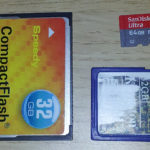
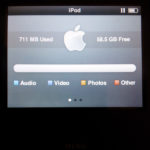
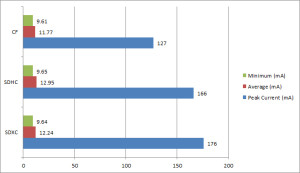
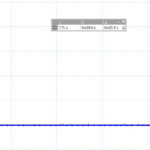
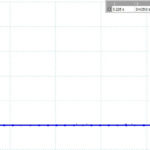
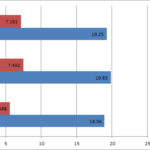
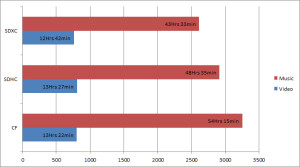
Sorry for reviving an old thread, but fairly new to this. Just secured myself a 7th gen classic and ordered the parts to migrate to the quad SD. Absolutely loved this comparison, but can anybody point me to data reflecting the current consumption of the HDD prior to the swap? I’m trying to determine whether or not I need to even order a new battery, when factoring in the assumed reduction in current drain by just swapping out the HDD initially.
@Joshua – Our last power consumption article can be found here Runtime Shootout, it covers all of our boards and the original HDD.
@Tarkan – Thanks! Much appreciated!
Hello Joshua, i want to do the same thing, did everything fit nicely with the thin back cover or do we need the thick one? thank you!
Hello – wondering if anyone has any new experience with the 3000mAh battery kit? I’m considering buying one, but without much data from users, I’m very skeptical. Especially since the seller will not confirm whether or not the hardware/components for the headphone jack are OEM.
So, if anyone has any experience(s) to share with this setup, I’d really appreciate it.
Thank you,
TG
@Tommy Gunn – I have bought the battery itself – cell used seems ok, it is a standard sized cell (58mm x 79mm x 3.8mm) so specs are ok. Do not have any experience with the hardware components, to guarantee OEM you would probably have to buy a trashed iPod on ebay – the headphone jacks I have been seeing tend to be either used/refurbed OEM or new 3rd party made.
I bought 3000mAh battery. Quite slim and fits inside nicely. Problem is, when the charger is plugged in, the iPod works fine. The minute I unplug, the iPod instantly turns off. Could it be that the battery is faulty or incompatible or just unable to hold enough juice from a standard iPod charger?
Anyone else used these batteries?
@CoCo – do you mean 2000mAh battery? I doubt if there is enough space in the iPod for an 3000mAh battery – anyhow, does sound like the battery is faulty anyway if it is not powering up the iPod properly.
@Support – It’s definitely 3000mAh – has it stamped on the battery. Apparently gives up to 180hrs playback. But it’s also from eBay so I’m not sure how legit it is. Took a gamble as the seller has 100% feedback. But I’ve just ordered the 2000mAh and have initiated a return for a refund for the 3000mAh
@CoCo – with batteries there is no magic involved, the mAh is defined by the volume/size of the battery, if the 2000mAh battery you get is the same size/volume then I would say the 3000mAh is not a real rating.
I have an ipod classic 5g with your CF adapter, i just saw the 2000mah battery and i was wondering if i can fit that battery in the ipod or if i’d have to buy the thicker case to make it fit. Do you know if it works?
@Angel – The 2000mAh will need the thick case back as the battery itself is around 4mm thick.
The Super-iPod 2,000mAh is a larger battery. Judging from the pictures I have seen it is about four times larger than Apple’s battery. The highest capacity factory battery I have seen are only 850mAh. The way they make the larger battery fit inside is by making the battery thinner and longer in its dimensions. They recommend using a thicker back for the iPod which you can buy as a kit along with their battery. But I am hoping that I won’t need to. Because I like it to stay thin. The SDXC iFlash Thin upgrade should allow me to keep the thin back plate due to its slimmer design. I ordered my 2,000mAh battery for my iPod. It shipped earlier this week. But it has not arrived yet.
@Joshua – Actually the iFlash-Thin allows the fitting of the 2000mAh, it does not change the fact you still need the thick case back to use it – the 2000mAh battery is over 3mm thick.